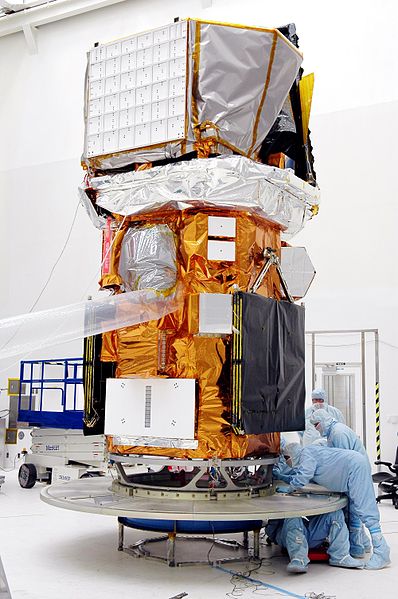Neil Gehrels Swift Observatory
Neil Gehrels Swift Observatory, previously called the Swift Gamma-Ray Burst Explorer, is a NASA three-telescope space observatory for studying gamma-ray bursts (GRBs) and monitoring the afterglow in X-ray, and UV/Visible light at the location of a burst. It was launched on 20 November 2004, aboard a Delta II launch vehicle. Headed by principal investigator Neil Gehrels until his death in February 2017, the mission was developed in a joint partnership between Goddard Space Flight Center (GSFC) and an international consortium from the United States, United Kingdom, and Italy. The mission is operated by Pennsylvania State University as part of NASA's Medium Explorer program (MIDEX).
Diagram of Burst Alert Telescope
Swift before launch
UVOT's "first light" image
A model of the satellite
In gamma-ray astronomy, gamma-ray bursts (GRBs) are immensely energetic explosions that have been observed in distant galaxies, described by NASA as "the most powerful class of explosions in the universe". They are the most energetic and luminous electromagnetic events since the Big Bang. Bursts can last from ten milliseconds to several hours. After an initial flash of gamma rays, a longer-lived "afterglow" is usually emitted at longer wavelengths.
Artist's illustration showing the life of a massive star as nuclear fusion converts lighter elements into heavier ones. When fusion no longer generates enough pressure to counteract gravity, the star rapidly collapses to form a black hole. Theoretically, energy may be released during the collapse along the axis of rotation to form a GRB.
Positions on the sky of all gamma-ray bursts detected during the BATSE mission. The distribution is isotropic, with no concentration towards the plane of the Milky Way, which runs horizontally through the center of the image.
The Italian–Dutch satellite BeppoSAX, launched in April 1996, provided the first accurate positions of gamma-ray bursts, allowing follow-up observations and identification of the sources.
NASA's Swift Spacecraft launched in November 2004








